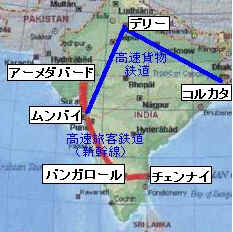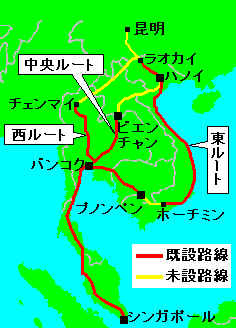トップページ
「人民網日本語版」2006年11月8日
中国とASEAN結ぶ汎アジア鉄道の建設が進行中
中国と東南アジア諸国連合(ASEAN)は現在、「汎アジア鉄道」の建設ペースを速めている。同鉄道は全長5500キロ。雲南省昆明を出発し、ラオス、ミャンマー、ベトナム、タイ、カンボジア、マレーシアを通過して終点シンガポールに到着する。これらの国々は、中国の鉄道網を通じてモンゴルやロシアの極東地域とつながり、アジア大陸を縦貫する鉄道ブリッジを形成する。中国、キルギス、ウズベキスタンの鉄道と合流して、両国の中央アジア鉄道とも連結することになる。
このほど昆明で開かれた「ASEAN―メコン川流域開発協力第8回汎アジア鉄道特別工作会議」で、中国鉄道部の陸東福副部長は、「中国は現在、国内の鉄道をどんどん建設しているところで、ASEAN諸国と一緒に汎アジア鉄道の一日も早い完成に向けて努力したい」と述べた。
http://www.unescap.org/TTDW/index.asp?MenuName=TheTrans-AsianRailway
The Trans-Asian Railway
(TAR) was initiated in the 1960s with the objective of providing
a continuous 14,000-km rail link between Singapore and Istanbul
(Turkey), with possible onward connections to Europe and Africa.
The link offered the potential to greatly shorten the distances
and reduce transit times between countries and regions, while
being a catalyst for the notion of international transport as a
tool for trade expansion, economic growth and cultural exchanges.
The international events that punctuated the 1960s, 1970s and
early 1980s influenced the momentum of the concept during these
three decades. However, with the political and economic changes
that took place in the region in the 1980s and early 1990s, the
development of the TAR concept was revived.
Given the extent of the territory covered, the differences in
standards, and differences in the levels of technical development
between railways in the region, ESCAP adopted a step-by-step
approach to define the TAR network. The network was initially
divided into four major components which were studied separately.
These components are:
(i) a northern corridor connecting the rail networks of China,
Kazakhstan, Mongolia, the Russian Federation and the Korean
Peninsula;
ii) a southern corridor connecting Thailand and the southern
Chinese province of Yunnan with Turkey through Myanmar,
Bangladesh, India, Pakistan and the Islamic Republic of Iran with
Sri Lanka also part of the corridor;
(iii) a subregional network covering the
ASEAN and Indo-China subregions; and
(iv) a north-south corridor linking Northern Europe to the
Persian Gulf through the Russian Federation, Central Asia and the
Caucasus region.
2005年12月28日
社団法人 国際港湾貨物流通協会
インドシナ半島への直接ルートの敷設は、これまで国連ESCAPが、「汎アジア高速道路網(AH:Asian
Highway)」や「汎アジア鉄道網(TAR:Trans-Asian
Railway)」の推進の一環として、早くから努力を傾注してきており、経済発展と共にアジア欧州首脳会議(ASEM)でも注目されるようになって、急速に実現への兆しが見えるようになった。
本年(2005年)3月、中国が、タイ−昆明間を結ぶ東部線(東ルート)への着工準備を発表し、シンガポール、クアラルンプール、バンコク、プノンペン、ホーチミン、ハノイを経て雲南省へと通じる全長5,500kmの「ASEAN・インドシナ半島」路線が、具体的に、検討の遡上にのぼるようになった。
中国では、中部線(中央ルート)や西部線(西ルート)の建設とともに、「第十一次五ヵ年計画」(2006年〜10年)でも、「中国−ヤンゴン間(昆明〜瑞麗〜ヤンゴン:約1,917km)」を結ぶ「南アジア横断鉄道」の敷設が計画に掲げられている。
 こうした、インドシナ半島における大国中国の主導権の発動は、同様に隣接する大国インドにとって穏やかなことではない。呼応するかのように、同国内でも顕著な変化が起るようになっている。商業都市ムンバイ(旧名ボンベイ)とアーメダバード、さらにはIT企業が集中するバンガロールから南部の中心都市チェンナイ(旧名マドラス)へと延びる新幹線網の計画が、昨年(2004年)末に発表された。
こうした、インドシナ半島における大国中国の主導権の発動は、同様に隣接する大国インドにとって穏やかなことではない。呼応するかのように、同国内でも顕著な変化が起るようになっている。商業都市ムンバイ(旧名ボンベイ)とアーメダバード、さらにはIT企業が集中するバンガロールから南部の中心都市チェンナイ(旧名マドラス)へと延びる新幹線網の計画が、昨年(2004年)末に発表された。
又、本年(2005年)6月には、デリーとムンバイ(1350km)、コルカタ(旧カルカッタ)(1450km)を結ぶアジア初の本格的な高速貨物専用鉄道の建設も発表され、日本とのタイアップによる急速な鉄道網の展開が話題を呼ぶようになっている。


 こうした、インドシナ半島における大国中国の主導権の発動は、同様に隣接する大国インドにとって穏やかなことではない。呼応するかのように、同国内でも顕著な変化が起るようになっている。商業都市ムンバイ(旧名ボンベイ)とアーメダバード、さらにはIT企業が集中するバンガロールから南部の中心都市チェンナイ(旧名マドラス)へと延びる新幹線網の計画が、昨年(2004年)末に発表された。
こうした、インドシナ半島における大国中国の主導権の発動は、同様に隣接する大国インドにとって穏やかなことではない。呼応するかのように、同国内でも顕著な変化が起るようになっている。商業都市ムンバイ(旧名ボンベイ)とアーメダバード、さらにはIT企業が集中するバンガロールから南部の中心都市チェンナイ(旧名マドラス)へと延びる新幹線網の計画が、昨年(2004年)末に発表された。